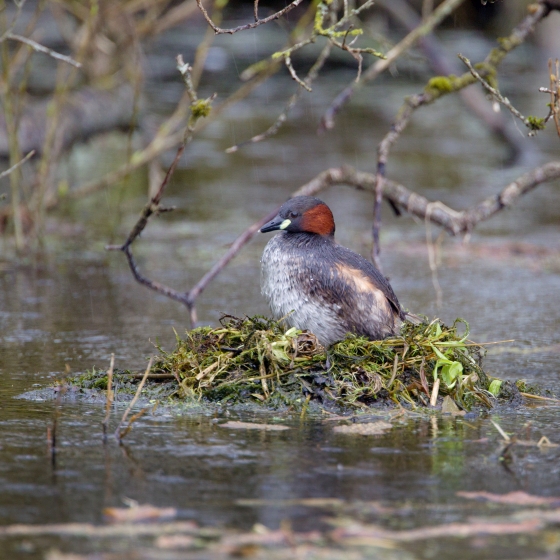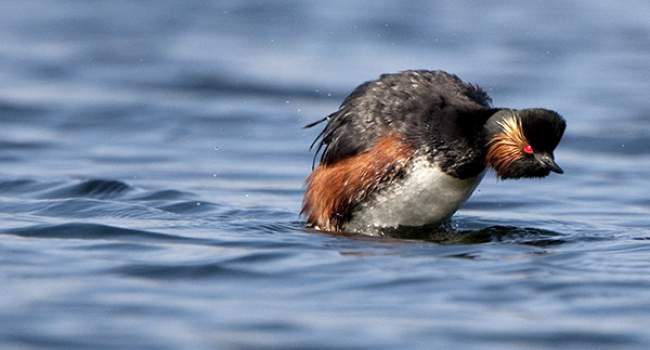Little Grebe
Tachybaptus ruficollis (Pallas, 1764)
LG
 LITGR
LITGR  70
70

Family: Podicipediformes > Podicipedidae

The smallest of our grebes, the Little Grebe occupies a broader range of waterbodies than its relatives, even being found breeding on small ponds on farmland or in urban parks.
Found across lowland Britain & Ireland, breeding Little Grebes may be overlooked because of their shy nature, often remaining hidden in emergent vegetation. Despite this they can be rather vocal, advertising their presence through a series of high-pitched calls.
During the winter months Little Grebes also occupy rivers, streams, and some brackish and coastal habitats. Our understanding of Little Grebe movements is far from complete; as well as the small distance movements of British breeding birds to wintering sites, there is evidence of birds from other populations arriving here in winter.
Exploring the trends for Little Grebe
Our Trends Explorer will also give you the latest insight into how the UK's Little Grebe population is changing.
trends explorerIdentification
Little Grebe identification is often straightforward. The following article may help when identifying Little Grebe.
Identifying small breeding Grebes

Small grebes in summer are gloriously-coloured birds, but two of the three species are unfamiliar to most. Poor light or frequently encountered partially moulted birds can also cause some identification headaches. Let us help you separate these beautiful birds.
- 1 of 2
- next ›
SONGS AND CALLS
Listen to example recordings of the main vocalisations of Little Grebe, provided by xeno-canto contributors.
Other
Begging call
Call
Develop your bird ID skills with our training courses
Our interactive online courses are a great way to develop your bird identification skills, whether you're new to the hobby or a competent birder looking to hone your abilities.
Browse training coursesStatus and Trends
Population size and trends and patterns of distribution based on BTO surveys and atlases with data collected by BTO volunteers.
CONSERVATION STATUS
This species can be found on the following statutory and conservation listings and schedules.
POPULATION CHANGE
The possible decline shown by the WBS/WBBS (which is not statistically significant) may reveal problems among birds on linear waterways during the early 1980s and since the late 1990s, but a possible increase in the BBS UK trend (also not significant) suggests that wider populations, including birds on small still waters, have been more healthy. Because of the shortage of data, and the conflict between WBS and BBS assessments, the rapid decline indicated by WBS in the 1980s did not initially trigger a conservation listing. After a period on the amber list through its UK decline during 2009-15, the species is now again on the green list (Eaton et al. 2015). In an analysis of nest record cards, Moss & Moss (1993) found that nests on ponds and lakes were significantly more successful than those on rivers and streams and that nests on rivers, subject to fluctuating water levels, experienced significantly higher failure rates through flooding than those on canals, where water levels are artificially maintained. Winter numbers show sustained shallow increase, apart from a brief period of decline between 2007/08 and 2012/2013 (WeBS: Frost et al. 2020). Numbers have been broadly stable across Europe since 1990 (PECBMS: PECBMS 2020a>).
| UK breeding population |
No population change in UK (1995–2022) 
|
| UK winter population |
+38% increase (1996/97–2021/22)  |
Exploring the trends for Little Grebe
Our Trends Explorer will also give you the latest insight into how the UK's Little Grebe population is changing.
trends explorerDISTRIBUTION
Breeding and winter distributions of Little Grebes are very similar, with birds widespread across most of the low-lying regions of Britain & Ireland, absent from parts of northern Scotland, the Pennines, Wales and southern Ireland, and most abundant along the major river valleys.
Occupied 10-km squares in UK
| No. occupied in breeding season | 1785 |
| % occupied in breeding season | 59 |
| No. occupied in winter | 1944 |
| % occupied in winter | 64 |
European Distribution Map
European Breeding Bird Atlas 2
Breeding Season Habitats
| Most frequent in |
Lakes 
|
| Also common in | Ponds |
DISTRIBUTION CHANGE
Since the 1981–84 Winter Atlas there has been a notable extension of range throughout Britain & Ireland with a 27% increase in the number of occupied 10-km squares. Winter numbers are poorly monitored by existing schemes because Little Grebes occupy many small wetlands and waterways that are not routinely surveyed.
Change in occupied 10-km squares in the UK
| % change in range in breeding season (1968–72 to 2008–11) | +20.4% |
| % change in range in winter (1981–84 to 2007–11) | +26.5% |
SEASONALITY
Little Grebes are present throughout the year, recorded on up to 10% of complete lists, with a dip in detection in late spring.

Movement
Information about movement and migration based on online bird portals (e.g. BirdTrack), Ringing schemes and tracking studies.
RINGING RECOVERIES
View a summary of recoveries in the Online Ringing Report.
Foreign locations of birds ringed or recovered in Britain & Ireland

Biology
Lifecycle and body size information about Little Grebe, including statistics on nesting, eggs and lifespan based on BTO ringing and nest recording data.
PRODUCTIVITY & NESTING
Number of Broods 
|
2 (3) |
Egg Size 
|
38×26 mm Weight = 13.7 g (of which 8% is shell) |
Exploring the trends for Little Grebe
Our Trends Explorer will also give you the latest insight into how the UK's Little Grebe population is changing.
trends explorerSURVIVAL & LONGEVITY
View number ringed each year in the Online Ringing Report
Maximum Age from Ringing 
|
6 years 0 months 23 days (set in 1995) 
|
Exploring the trends for Little Grebe
Our Trends Explorer will also give you the latest insight into how the UK's Little Grebe population is changing.
trends explorerBIOMETRICS
Wing Length 
|
Adults | 104.1±2.9 | Range 99–108mm, N=55 |
| Juveniles | 102.9±4.1 | Range 97-108mm, N=59 |
Body Weight 
|
Adults | 225±39.2 | Range 167–284g, N=51 |
| Juveniles | 209±48.9 | Range 119–276g, N=56 |
Feather measurements and photos on featherbase 
CODES & CLASSIFICATION
Ring size 
|
E or F |
Field Codes 
|
2-letter: LG | 5-letter code: LITGR | Euring: 70 |
For information in another language (where available) click on a linked name
Research
Interpretation and scientific publications about Little Grebe from BTO scientists.
CAUSES AND SOLUTIONS
Causes of change
There is little good evidence available regarding the drivers of the breeding population change in this species in the UK.
Further information on causes of change
No further information is available.
Information about conservation actions
The decline of this species contrasts with the increases observed for many other wetland species and, as the reasons for the observed WBBS decline are unknown, so potential conservation actions are also unclear. Theoretically, actions to maintain and create wetland habitats and to provide nesting sites for other wildfowl are also likely to support this species. However, like the Moorhen, this species can be found breeding on smaller patches of suitable habitat in the wider countryside, such as farm ponds; therefore actions to protect and create such habitats should also be considered to benefit the Little Grebe.
Links to more studies from ConservationEvidence.com
- A strategy for minimizing waterfowl deaths on toxic waterbodies
- Post-release survival of oiled, cleaned seabirds in North America
- Behavioral responses of wintering great crested grebes to dissuasion experiments: implications for management
Read more studies about Little Grebe on Conservation Evidence >
Would you like to search for another species?














Share this page